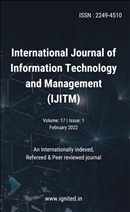Women as Entrepreneurs in India: Challenges and Opportunities
Main Article Content
Authors
Abstract
In the nation, the Women's entrepreneurship becomes the newest buzzword, as women aredemonstrating their abilities in a variety of fields and outperforming men in certain areas. Women areexcelling in a variety of professions these days, like pilot, engineer, scientist, doctor, lawyer, teacher andso on. If women can do these occupations so well while still managing their homes, why can't theyoperate a business effectively? Women are simply more competent of running a business than men.Women are deprived of opportunities, information, and expertise despite having a lot of aptitude andtalents for running a business. The current study examines the state of women's entrepreneurship inIndia, as well as the opportunities and obstacles that Indian women entrepreneurs face. This study alsohighlights the achievements of a few Indian women entrepreneurs. The research is based on secondarydata gathered from publicly available sources. Women's entrepreneurship, according to academics,serves a dual purpose. It empowers women first, and it contributes to national economic prosperitysecond. The Indian government has established a slew of programmes and laws aimed at speeding upthe process of creating jobs for women and assisting current female entrepreneurs in scaling up theirbusinesses. However, in both normal times and during the COVID-19 epidemic, legislative initiativesaimed at assisting women-owned businesses and the national economy have failed to reach a largenumber of extremely small-scale women entrepreneurs.
Downloads
Download data is not yet available.
Article Details
Section
Articles
References
- Abraham, R., Basole, A., & Kesar, S. (2021). Tracking employment trajectories during the covid-19 pandemic: Evidence from Indian panel data. Working Paper 35. Centre for Sustainable Employment, Azim Premji University.
- Ayadurai, S. (2006). An insight into the ‘constraints’ faced by women entrepreneurs in a war-torn area: Case study of the northeast of Sri Lanka. Journal of Asia Entrepreneurship and Sustainability, 2(1), 1.
- Bain and Google (2019). Powering the economy with her. Women entrepreneurship in India. Pandey, R., & Pillai, A. (2020). Covid-19 and MSMEs: The ‘identification’ problem. Ideas for India.
- Bargotra, N., Bhatotia, K., Karthick, M. P., & Narasimhan (2021). How did the Indian women enterprises fair during Covid-19 lockdown?. Economic and Political Weekly, 56(19), 8 May, 2021.
- Ebert, M. (2021). Women entrepreneurs’ resilience in times of Covid-19. Deutsche Gesellschaft für Internationale Zusammenarbeit (GIZ) GmbH.
- Galiani, S., Meléndez, M., & Ahumada, C. N. (2017). On the effect of the costs of operating formally: New experimental evidence. Labour Economics, 45, 143–157.
- Gupta, S. and Aggarwal, A. (2015), Opportunities and challenges faced by women entrepreneurs in India. IOSR Journal of Business and Management (IOSR-JBM). 17(8). Ver. III (August 2015), 69-73. e-ISSN: 2278-487X, p-ISSN: 2319-7668.
- Jayachandran, S. (2020). Microentrepreneurship in developing countries. Working Paper 26661. MSME (2021). Annual report: 2020–2021. Ministry of Micro, Small and Medium Enterprises (MSMEs), Government of India
- Lenka, U., & Agarwal, S. (2017). Role of women entrepreneurs and NGOs in promoting entrepreneurship: Case studies from Uttarakhand, India. Journal of Asia Business Studies, 11(7), doi: 10.1108/JABS-07-2015-0088.
- Lundberg, S., & Rose, E. (1999). The Determinants of Specialization within Marriage. Hong Kong: School of Economics and Finance, University of Hong Kong.
- Mehrotra, S., & Giri, T. (2019). The size structure of India's enterprises: Not just the middle is missing. CSE working paper No 25. Centre for Sustainable Employment, Azim Premji University.
- Milazzo, A., & Goldstein, M. (2019). Governance and women’s economic and political participation: Power inequalities, formal constraints and norms. The World Bank Research Observer, 34(1), 34–64, doi: 10.1093/wbro/lky006, February 2019.
- Misra, S. S., & Tejas, P. (2021). The inequality virus: India supplement 2021, 22 January.
- NSCI (2021). Badhate Kadam. News letter, February 2021.
- OECD (2020). OECD policy responses to coronavirus (COVID-19): Women at the core of the fight against COVID-19 crisis, Version 1st April 2020.
- Pandey, R., & Pillai, A. (2020). Covid-19 and MSMEs: The ‘identification’ problem. Ideas for India.
- Rothenberg, A. D., Gaduh, A., Burger, N. E., Chazali, C., Tjandraningsih, I., Radikun, R., … Weilant, S. (2016). Rethinking Indonesia’s informal sector. World Development, 80, 96–113.
- Singh, N. (2020). Naari Shakti and women’s agency in the politics of India. In N. H. Akhtar, & P. Jolly (Eds.), Women’s Voice: A Search for Feminist Consciousness (pp. 456–470).
- Singh, S., Farooquee, N. A., & Pattanaik, B. K. (2017). Food security, gender, and occupational seasonality in urban low-income households. International Public Health Journal, 9(3), 267–274.
- Taylor, R., & Newcomer, J. (2005). Characteristics of women small business owners. In S. Fielden, & J. Davidson (Eds.), International Handbook of Women and Small Business Entrepreneurship. Northampton, Massachusetts: Edward Elgar Publishing.
- Udyam (2021). Analysis of Udyam Registration Data (MSME Registered up to 30th June, 2021). Delhi: Office of Development Commissioner (MSME), Ministry of Micro, Small and Medium Enterprises, Government of India.
- UN Women (2020). COVID-19 and its economic toll on women: The story behind the numbers, Wednesday, 16 September 2020. UN Women (2021). Your questions answered: Women and covid-19 in India.

